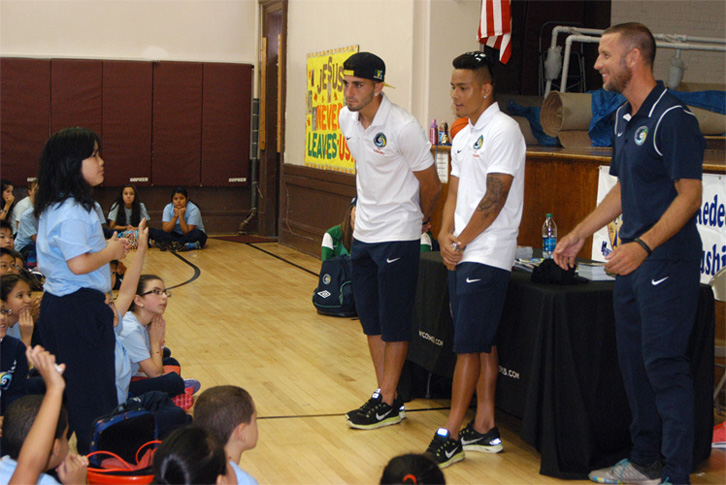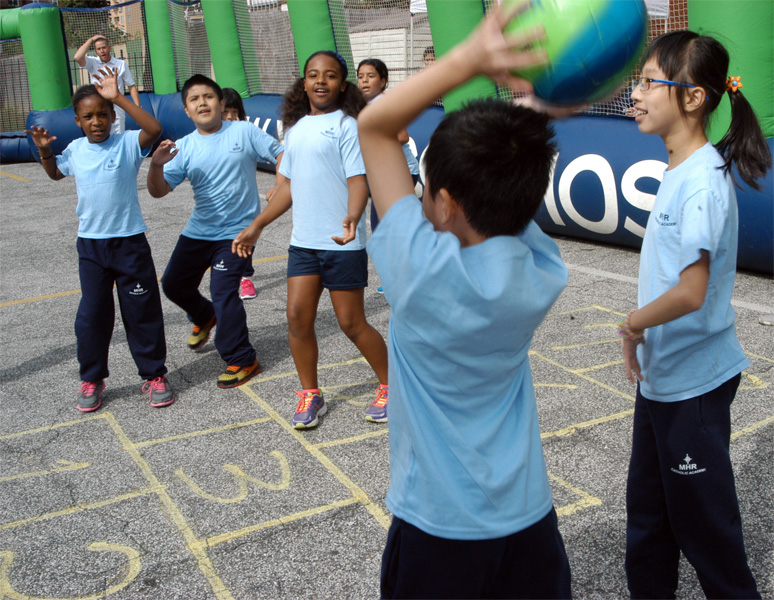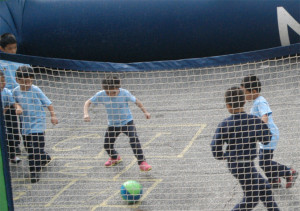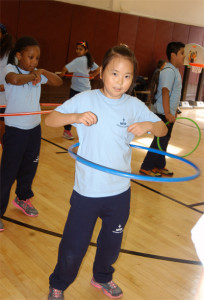
by Marie Elena Giossi
Two Queens soccer players helped kick-off an initiative geared toward teaching children about healthier eating and active living at Most Holy Redeemer Catholic Academy in Flushing.
In response to high rates of childhood obesity across the country and state, Most Holy Redeemer has partnered with New York Hospital Queens and the New York Cosmos soccer club on a three-year project to address obesity on a local level and encourage students and their families to adopt healthier lifestyles.
Spearheading the project at the school is Nilda Tirado, a nutritionist who sits on the school board.
“It’s important for children to not only grow academically but physically,” said Tirado, who fears that apartment living with more concrete than grassy spaces means children have fewer opportunities for outdoor play.
Inactivity combined with the convenience and low cost of fast food for working parents makes for an unhealthy lifestyle.
The primary purposes of the project are to help children identify ways they can increase their physical activity and teach parents how to make nutritious meal choices for their families.
“Parents, teachers and physicians are working together because we need the whole community to help our children,” Tirado said.
New York Cosmos players David Diosa and Sebastián Guenzatti joined the school community for its Action Kick-off on Wednesday, Sept. 24. They spoke and answered students’ questions about practice and playing schedules, how they exercise and the importance of eating properly to stay at the top of their game.

Meeting the players was the culmination of a day devoted to fitness, with activity stations located throughout the gym and an inflatable soccer field in the yard. After taking part in the activities, including basketball, tug of war and freeze dancing, students were invited to sample five varieties of apples.
“We want to teach them healthy habits now before they grow into obese adults,” explained New York Hospital Queens representative Camille Glotzbecker, who helped conduct the activities. Staving off obesity-related diseases, including hypertension and diabetes, is the ultimate goal.
As part of the project, the school has been provided with a physical education teacher, and parents have received information on proper eating habits and preparing nutritious recipes. Health professionals will track students’ weight and body mass index over the next three years.
Not only have the New York Cosmos participated in school events, but the club is also offering an afterschool soccer clinic at a reduced cost for all neighborhood children this fall.
“This is an opportunity for us to give back on a regular basis,” shared Stephen Hoogerwerf, youth program coordinator for the New York Cosmos.
He feels soccer is an ideal partner sport for this exercise initiative because it’s growing in global popularity, players are constantly in motion and it teaches students about working together as a team. An added benefit is that children learn to play the game correctly from professional coaches.
Helping children and their families combat obesity requires a team effort, and that team includes parents, which is why Principal Maureen Rogone invited parents to volunteer at the event to see how easy it can be to get children moving.
Parent-volunteer Dr. Charles Hwu, a cardiologist with a son in first grade, ran the basketball station.
“I encourage my son to do different kinds of healthy activities,” said Dr. Hwu. “I teach him there is a connection between exercise, food and health.”
He felt that students enjoyed the event because “it combines exercise and fun.”
 “Before I thought exercising was doing things you really didn’t like,” admitted Mia Lin, an eighth grader. “Now I see that you can do things you enjoy and have fun.”
“Before I thought exercising was doing things you really didn’t like,” admitted Mia Lin, an eighth grader. “Now I see that you can do things you enjoy and have fun.”
Last June, the nutrition aspect of the project was launched with an event for school families featuring sampling stations of American, Latin and Asian fare, reflective of the student body; health professionals who educated parents and a chance for children to play soccer. Recipes were distributed to the families and continue to be made available through the school website.
“We have a diverse community and food habits are different,” said Tirado, who noted that many families in the school come from Latin America and China. “Sometimes children … want to change their food habits – and not for the better.”
Seventh grader Boyuan Zhang admitted, “I used to eat a lot of junk food and now I’ve learned what I should eat and in what amounts.”
Zhang says that in light of what he’s been taught at school, he has started eating apples and drinking milk.
